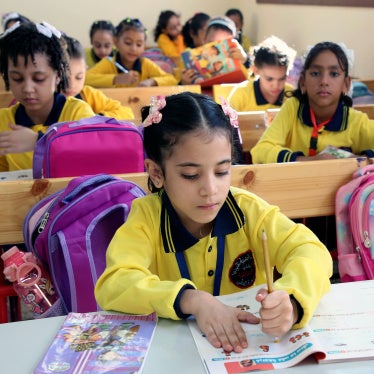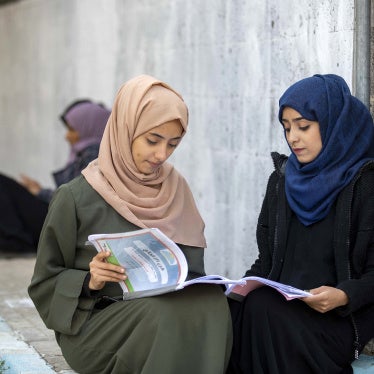1. What is female genital mutilation (FGM)?
The World Health Organization (WHO) defines FGM as "all procedures involving partial or total removal of the external female genitalia or injury to the female genital organs for non-medical reasons."
2. What is the difference between female genital mutilation (FGM), female genital cutting (FGC), and female circumcision?
These are all terms used to refer to the practice of removing part of female genitalia for non-medical reasons:
- Female genital mutilation (FGM) is a term used by many human rights groups and health advocates to emphasize the physical, emotional, and psychological consequences associated with this procedure. This term also identifies the practice as a human rights violation because of the violence associated with the procedure and because it is mostly carried out on young girls. In its report "They Took Me and Told Me Nothing: Female Genital Mutilation in Iraqi Kurdistan," Human Rights Watch uses the term female genital mutilation or FGM.
- Female genital cutting (FGC) is a term that is also used by activists and health advocates to show the dangers associated with the practice. This term is sometimes also referred to as female genital mutilation/cutting or FGM/C.
- Female circumcision is a term used to describe the practice that does not take into consideration the harm associated with it. It is misleading because it implicitly compares the practice with male circumcision, regardless of the fact that FGM is a considerably more invasive procedure and is not conducted for medical purposes.
3. How many types of FGM are there and what do the different procedures entail?
There are four types of FGM classified by the WHO:
- Type I includes the partial or total removal of the clitoris and/or prepuce. Known as clitoridectomy, this is the most common form believed to be practiced in Iraqi Kurdistan.
- Type II is a more invasive procedure that includes the partial or total removal of the clitoris and the labia minora. This can be performed with or without excision of the labia majora and is known as excision.
- Type III is the most severe type of FGM, known as infibulation, which involves the narrowing of the vaginal orifice with the creation of a seal that is formed by cutting and then stitching the labia minora and/or the labia majora with or without excision of the clitoris.
- The fourth type of FGM includes all other harmful procedures to the female genitalia including pricking, piercing, incising, scraping, and cauterization.
4. Which types of FGM are commonly practiced worldwide?
Globally, Type I and Type II are the most common FGM procedures. They account for more than 85 percent of all procedures.
5. At what age do girls undergo FGM?
The WHO notes that most girls undergo this practice between birth and age 15, but FGM occurs at all ages. In some cultures, FGM is used to initiate girls into adulthood and to ensure their marriageability.
6. What is the worldwide prevalence of FGM?
The WHO estimates that more than 140 million girls and women globally have undergone this procedure.
More than 3 million girls in Africa alone are at risk of undergoing this practice every year.
7. In which countries is FGM practiced?
FGM is practiced in more than 27 countries in the African subcontinent, and in communities in Malaysia and Indonesia in Asia. FGM is also common among migrant communities in North America, Europe, and Australia.
In the Middle East and North Africa, FGM is practiced in countries such as Egypt, Yemen, and Iraqi Kurdistan. FGM is also believed to be practiced to a lesser extent among communities in Oman, Jordan, and the Occupied Palestinian Territories and was practiced by Falasha Jews in Ethiopia. Recent studies also reveal that FGM is practiced in Kurdish communities in Iran.
8. What are the most common reasons used to justify this harmful practice?
Those who practice FGM justify it with references to various socio-cultural factors. Many people from communities that practice it say that it is rooted in local culture and that the tradition has been passed from one generation to another. Culture and the preservation of cultural identity serve as the underlying impetus for continuing the practice.
Other common justifications for FGM are closely related to fixed gender roles and perceptions of women and girls as gatekeepers of their family's honor, which in many cases is closely linked to strict expectations regarding women's sexual "purity" and lack of desire. In some societies, the prevailing myth is that girls' sexual desires must be controlled early to preserve their virginity and prevent immorality. In other communities, FGM is seen as necessary to ensure marital fidelity and to prevent deviant sexual behavior.
Some of those who support FGM also justify it on grounds of hygiene and aesthetics, with notions that female genitalia are dirty and that a girl who has not undergone the procedure is unclean. Where such beliefs are prevalent, a girl's chances of getting married are materially reduced if she has not undergone the procedure. FGM is also sometimes considered to make girls attractive. Infibulation, for instance, is thought to achieve smoothness, which is considered beautiful.
9. Does any religion condone the practice of FGM?
FGM is practiced among some adherents of the Muslim, Christian, and Jewish faiths. FGM is also practiced among some animists, who believe in the existence of individual spirits and supernatural forces. It is erroneously linked to religion, is not particular to any religious faith, and predates Christianity and Islam. However, some adherents of these religions believe the practice is compulsory for followers of the religion. Because of this flawed link to various religions, and specifically to Islam, religious leaders have an important role to play in dissociating FGM from religion.
For example, while FGM is practiced in Egypt, which is predominantly Muslim, it is not practiced in many other countries with predominantly Muslim populations, such as Saudi Arabia and Pakistan. The association of FGM with Islam has been refuted by many Muslim scholars and theologians who say that FGM is not prescribed in the Quran and is contradictory to the teachings of Islam.
10. What is the worldwide legal status of FGM?
Countries with laws or regulations against FGM include Burkina Faso, Central African Republic, Djibouti, Ghana, United Kingdom, Guinea, Sudan, Sweden, and the United States.
Canada, France, and the United Kingdom also have existing laws against assault and child abuse that cover FGM.
Governments that support FGM eradication include Benin, Burkina Faso, Cameroon, Central African Republic, Cote d'Ivoire, Djibouti, Egypt, Eritrea, Ethiopia, Gambia, Guinea, Kenya, Niger, Senegal, Sudan, Tanzania, Togo, and Uganda.
11. What are some of the consequences associated with FGM?
FGM has immediate and long-term effects on a woman's physical, sexual, and emotional health.
Physical health implications may include severe bleeding or hemorrhaging, shock from the pain associated with the procedure, risk of infections - especially when unsterile cutting instruments are used or if they are used on several girls at once - and urinary retention. Long-term complications include anemia, cysts, scarring, difficulty passing urine, menstrual disorders, recurrent urinary tract infections, fistulas, prolonged labor, and infertility. More recent research shows that women who have experienced any type of FGM, including clitoridectomy, run a greater risk of complications during childbirth. Pregnant women carry a greater risk of needing a caesarean section or an episiotomy and may experience postpartum hemorrhage.
Sexual and psychosexual health implications may include painful sexual intercourse, sexual dysfunction, and hypersensitivity in the genital area. FGM has also been associated with infertility, which may be attributed to infections or inadequate penetration during sexual intercourse. In communities where fertility and childbirth constitute major roles for women, the failure to produce children is most often blamed on women. This may result in the rejection of the infertile woman by her husband and his family.
Psychosexual problems may result from the pain associated with the procedure, painful menstruation, or painful intercourse that may occur as a result of the procedure. Recurring episodes of lack of sexual desire and enjoyment during intercourse may also result in psychosexual health complications.
Mental and emotional health implications may include depression, anxiety, phobias, post traumatic stress disorder (PTSD), psychosexual problems, and other mental health problems.
FGM is a medically unnecessary and irreversible procedure that damages the health of millions of girls worldwide.
12. How does FGM violate the human rights of children and women?
FGM violates women's and children's human rights, including their rights to health, to be free from violence, to life and physical integrity, to non-discrimination, and to be free from cruel, inhuman, and degrading treatment. When young girls are cut, they may bleed severely or become susceptible to a serious infection, especially when unsterile cutting instruments, such as knives or razors, are used. The procedure, which serves no medical purpose and is irreversible, inflicts severe pain on young girls and can be life-threatening.
Specific articles in international treaties, such as the International Covenant on Economic, Social and Cultural Rights (ICESCR), the Convention on the Elimination of All Forms of Discrimination against Women (CEDAW), and the Convention on the Rights of the Child (CRC), note the obligations of countries that are parties to the treaty to ensure the above-mentioned rights to girls and women.
13. What sorts of international frameworks or strategies have been established to help address FGM?
Treaty monitoring bodies such as the CEDAW Committee, the Committee on the Rights of the Child, the Committee Against Torture, and the Human Rights Committee have addressed FGM in their reports to specific governments and recommended actions that can feasibly be taken to help end this harmful practice. United Nations special rapporteurs have also made specific recommendations to governments in countries where FGM is common and recommended specific actions to help eradicate FGM, whether legislative or programs to combat the practice.
UN agencies such as the World Health Organization (WHO), the United Nations Children's Fund (UNICEF), and the United Nations Population Fund (UNFPA) have issued statements against FGM. They have also published documents that contain specific recommendations for policies and programs to help eradicate FGM.
14. Does the medical community have any responsibility for eradicating FGM?
The medical community plays an important role in helping to end this harmful practice. Health care workers have a primary responsibility to disseminate accurate information on the health effects of the practice, and should therefore be fully aware of the consequences of FGM. They should also be able to treat complications resulting from FGM.
The Plan of Action for the Elimination of Harmful Traditional Practices Affecting the Health of Women and Children, prepared in 1994 by the second UN Regional Seminar, developed a state action plan to address harmful traditional practices, including FGM, that includes the following components:
- Including instruction on the harmful effects of such practices in health and sex education programs.
- Introducing topics related to traditional practices affecting the health of women and children into literacy campaigns.
- Developing audio-visual programs and seeking articles in the press on traditional practices adversely affecting the health of young girls and children, particularly FGM.
15. What can governments do to help eradicate FGM?
To be effective, FGM eradication programs should be led by governments and carried out at national, regional, and local levels. These efforts should entail:
- Making a strong and visible political commitment to ending FGM.
- Developing a legislative and policy framework to eradicate FGM, including a law banning the practice for girls and non-consenting adult women .
- Mainstreaming FGM prevention strategies into policies and programs that deal with reproductive health, education, and literacy development.
- Providing accurate and accessible information and education about FGM.
- Mobilizing communities to develop their own FGM eradication strategies.








